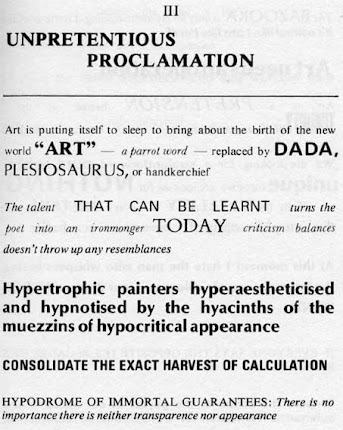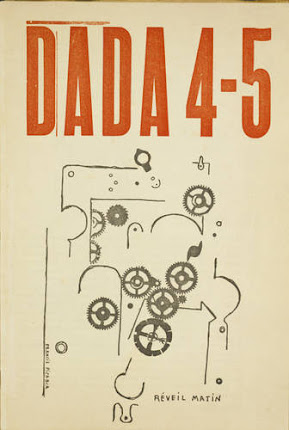Artists Among Poets - Dadaism
Dadaism is a cultural movement that began in Zürich during World War I and peaked from 1916 to 1922. The movement primarily involved visual arts, literature—poetry, art manifestoes, art theory—theatre, and graphic design, and concentrated its anti-war politics through a rejection of the prevailing standards in art through anti-art cultural works. Its purpose was to ridicule what its participants considered to be the meaninglessness of the modern world.
Purpose and Reach
The purpose of Dadaism was to ridicule what its participants considered to be the meaninglessness of the modern world. In addition to being anti-war, Dada was also anti-bourgeois and anarchistic in nature.
Dada activities included public gatherings, demonstrations, and publication of art/literary journals; passionate coverage of art, politics, and culture were topics often discussed in a variety of media.
Dada is the groundwork to abstract art and sound poetry, a starting point for performance art, a prelude to postmodernism, an influence on pop art, a celebration of anti-art to be later embraced for anarchic-political uses in the 1960s and the movement that lay the foundation for Surrealism.
Unpretention Proclamation - Tristan Tzara

In his poetry, Tzara would use the language and layouts of broadsides and marketing advertisements to embed political, consumerist, and capitalistic undertones into the nature and presentation of his anti-anti works.
"I say unto you: there is no beginning and we do not tremble, we are not sentimental. We are a furious Wind, tearing the dirty linen of clouds and prayers, preparing the great spectacle of disaster, fire, decomposition. We will put an end to mourning and replace tears by sirens screeching from one continent to another. Pavilions of intense joy and widowers with the sadness of poison. Dada is the signboard of abstraction; advertising and business are also elements of poetry." – Tristan Tzara
To Make a Dadaist Poem
Take a newspaper.
Take some scissors.
Choose from this paper an article the length
you want to make your poem.
Cut out the article.
Next carefully cut out each of the words that make up
this article and put them all in a bag.
Shake gently.
Next take out each cutting one after the other.
Copy conscientiously in the order in which they
left the bag.
The poem will resemble you.
And there you are--an infinitely original author of
charming sensibility, even though unappreciated by the vulgar herd.
~Tristan Tzara
Dadaism in New York
Coming from France in 1915, Marcel Duchamp and Francis Picabia met American artist Man Ray. By 1916 the three of them became the center of radical anti-art activities in the United States. Much of their activity centered in Alfred Stieglitz's gallery, 291.
The New Yorkers, though not particularly organized, called their activities Dada, but they did not issue manifestos. They issued challenges to art and culture through publications such as The Blind Man, Rongwrong, and New York Dada in which they criticized the traditionalist basis for museum art.
During this time Duchamp began exhibiting "readymades" (found objects) such as a bottle rack, and got involved with the Society of Independent Artists. In 1917 he submitted the now famous Fountain, a urinal signed R. Mutt, to the Society of Independent Artists show only to have the piece rejected. First an object of scorn within the arts community, the Fountain has since become almost canonized by some. The committee presiding over Britain's prestigious Turner Prize in 2004, for example, called it "the most influential work of modern art."
In an attempt to "pay homage to the spirit of Dada" a performance artist named Pierre Pinoncelli made a crack in The Fountain with a hammer in January 2006; he also urinated on it in 1993.
Tristan Tzara Une-Nuit-d-Echecs-Gras 1920

Dada Words
Duchamp claimed that his goal was to put art back in the service of the mind—to free it from merely perceptual, retinal preoccupations—and in his opinion Dada meant bringing visual art back in to the orbit o the literary Imagination. For him Dada was ‘an extreme protest against the physical side of painting. It was a metaphysical attitude. It was intimately ad consciously involved with literature.’
Duchamp found in the work of Jarry and Roussel models for the kind of severing of words from normal usage that had appealed to Picabia, and sought out the deliberately nonsensical. Central to his philosophy, therefore, would be the principle of indifference, an attitude that was intended to ensure the avoidance of self-expression or the taking of a position in order instead to pursue a detached art of practical, though unorthodox and often amusing philosophical speculation. The concept of the ‘readymade’ was a central part of his strategy, and in effect it constitutes a new kind of visual-verbal hybrid: “one important characteristic was the short sentence which I occasionally inscribed on the readymade,” Duchamp said. “That sentence instead of describing the object like a title was mean to carry the mind of the spectator toward other regions more verbal.
Motivated by the belief that because language offers no direct access to an objective reality or truth it should be treated as a system of arbitrary signs to be manipulated at will, Duchamp practiced an extreme form of nominalism that deliberately robbed language of its metaphoric range, forcing it to be taken literally. Recognition of both the opacity and the conventionality of language therefore led Duchamp to regard the word as a mere assemblage of letters devoid of intrinsic meaning, and sentences as a body of clichés, aphorism, proverbs and dictums. “Words are absolutely a pest as far as getting anywhere, Duchamp declared. “You cannot express anything through words.” The goal was thus to exhaust the normal meaning of existing words and to expose this purely conventional states. Words were subjected to a ceaseless play of allusion, puns, anagrams, cryptograms and suggestive brevities.
Dada Sound Poem Animated
Alarm Clock - Francis Picabia
